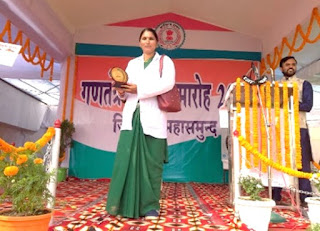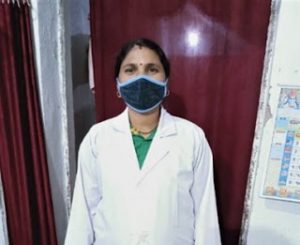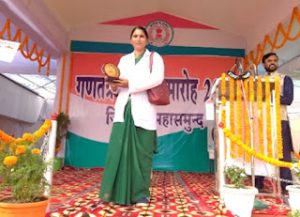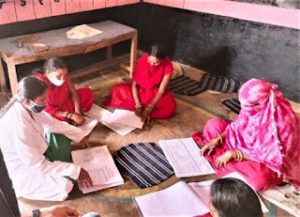


My role as Program Officer gives me the opportunity to closely interact with several frontline health workers. Over the last several months, I came across some remarkable women who showed that if you have the will, you can achieve your aspirations despite all odds. I wish to narrate an inspiring story of one such person from Mahasamund district, Motin Sahu, and the challenges she went through during her journey from Mitanin (similar to an ASHA worker) to Auxiliary Nurse Midwife (ANM) [Note 1] – a role she always dreamed of.

Motin Sahu (41 years old) in her current role as an ANM
Since Motin was a child, she wanted to help her community when she grew up. But as is the norm in traditional societies across rural India, she got married very early. It was a long road for Motin. She worked as a teacher right after marriage. Despite support from her family and neighbors, she had to quit shortly since her Mama-Sasur (uncle-in-law) started teaching in the same school. Managing work alongside practicing parda (a patriarchal custom where daughters-in-law cover their heads and face with a veil in the presence of male members of the husband’s family) was made it impossible for her to work as a teacher.
Motin then took up the role of Rojgaar Sahayak (a village-level position within the government’s employment department). She ensured people would get paid their daily wages on time and maintained records. She stayed true to her dream of helping people and this brought her happiness. Alongside, she also volunteered to become the village’s Mitanin, despite not receiving any money for this job. A Mitanin is called an ASHA in other states – asha, in Hindi, also means “hope”. “Mitanins give people living in rural areas hope by allowing them to realize their potential, regardless of their background, caste, or religion”, Motin said to me.
Motin was often asked by people not to work multiple jobs simultaneously, but Motin did not let these comments bring her down and give up on her commitment to serve the society. After six years of hard work as both a Rojgaar Sahayak and a Mitanin, she got an opportunity to apply for the role of ANM. Backed with her good grades in the 12th standard, her extensive experience on the field, and her passion towards improving people’s health, she enrolled in a two-year ANM training program from 2014 to 2016. Soon after, she was appointed as an ANM.
Currently working as an ANM, Motin looks after five villages. She provides basic health services such as ante-natal care, immunization for children, management of malnourished children, among others. She also guides her ASHAs and anganwadi workers and works collaboratively with them as part of the AAM Platform (Antara Foundation’s intervention that brings the three frontline workers on a common data-sharing platform). Motin’s work is appreciated by all, and she was recognized by the district administration for commendable implementation of government schemes within her jurisdiction in January 2021.

Motin receiving an award from the government

Motin (left-most) leading an AAM Meeting (AAM stands for ANM, ASHA and Mitanin collectively) after a monthly Village Health and Nutrition Day (VHND)
I believe frontline health workers in India are the foundation of our public health system. Appreciation and encouragement for their work goes a long way to motivate them to work within the difficult rural Indian landscape, and conveys the importance of their work to their communities. I am happy to contribute through Antara Foundation’s efforts to build frontline workers’ knowledge and support them with tools that make their jobs more effective and easier to execute.
If one Motin Sahu can become a role model for rural adolescent girls in her village, imagine what other women like her can accomplish with the right tools and motivation. I hope to watch the health sector gain many more strong women like Motin.
Disclaimer: The article has been written in personal capacity, and the views and opinions expressed are those of the author
[Note 1] An ANM (or the village nurse) is one of the three community health workers present in each village in India. The other two being the ASHA worker (village health mobilizer) and the anganwadi worker (nutrition caretaker for mothers and children), who support the ANM in providing basic health and nutrition services in their villages.